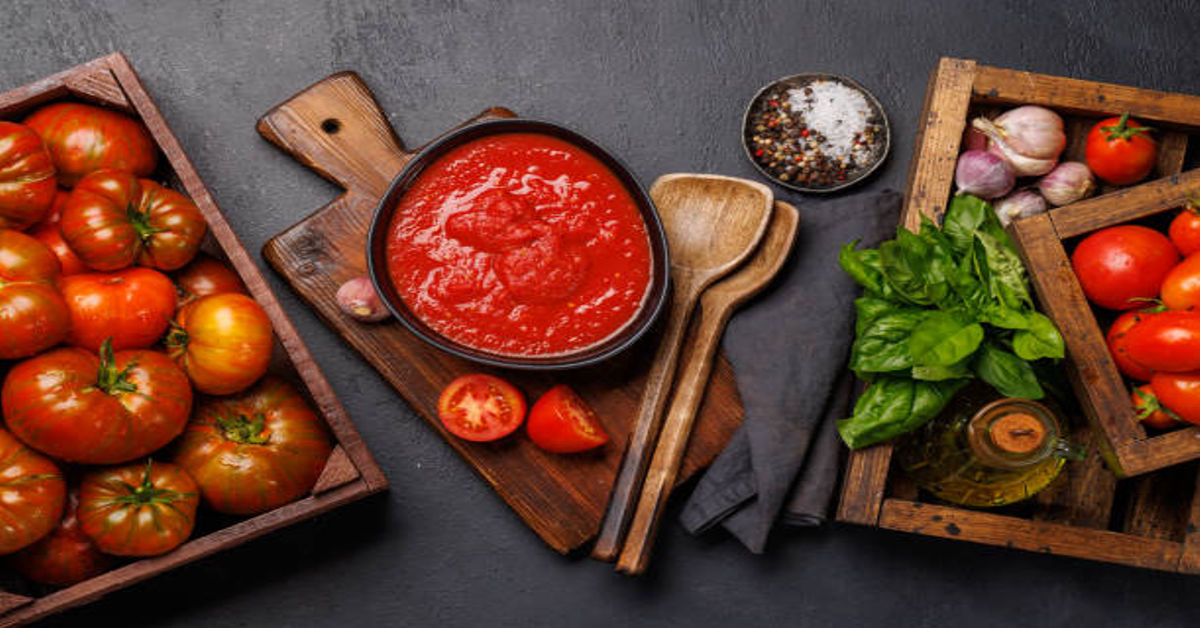Pomodoro sauce is one of the most iconic sauces in Italian cuisine, known for its bright, fresh flavor and remarkable simplicity. Its name, “pomodoro,” literally means “tomato” in Italian, and the sauce primarily consists of ripe tomatoes, olive oil, garlic, onions, and herbs. Despite its minimal ingredients, the flavor depth of a well-prepared pomodoro sauce is profound, offering a delicate balance of acidity, sweetness, and aromatic richness. The sauce serves as the cornerstone for countless Italian dishes, from classic spaghetti al pomodoro to more elaborate preparations in baked pasta dishes, seafood, and poultry recipes. Understanding pomodoro sauce in its entirety requires exploring its historical origins, the science behind tomato flavors, regional variations, culinary applications, and techniques for perfect execution.
1. Historical Origins of Pomodoro Sauce
Pomodoro sauce, while ubiquitous in modern Italian cooking, has a fascinating historical trajectory. Tomatoes are native to South America and were introduced to Europe in the early 16th century following the Columbian exchange. Initially, tomatoes were met with skepticism in Europe; they were often considered ornamental plants or even toxic due to their resemblance to nightshades. It was only by the 18th century that southern Italians began experimenting with tomatoes in culinary applications.
The earliest recorded use of tomatoes in Italian cooking was in the Naples region, where fresh tomatoes were incorporated into simple preparations, including the precursor to pomodoro sauce. This sauce was designed to enhance pasta dishes, which were becoming central to Italian cuisine during that period. By the 19th century, pomodoro sauce had evolved into a staple of Italian home cooking, celebrated for its ease of preparation and versatility. The sauce also gained prominence due to the widespread cultivation of tomatoes in Campania, Sicily, and Puglia, regions whose fertile soils and favorable climates produced the juicy, flavorful tomatoes ideal for sauce-making.
The historical significance of pomodoro sauce extends beyond mere culinary use. It symbolizes the adaptation of New World ingredients to European tastes and represents the Italian emphasis on fresh, seasonal, and regionally sourced ingredients. Over time, the sauce evolved into a culinary icon, embodying the principles of Italian cuisine: simplicity, balance, and respect for natural flavors.
2. Essential Ingredients of Pomodoro Sauce
A classic pomodoro sauce relies on high-quality ingredients, where each component contributes to the overall flavor profile. While variations exist, a traditional pomodoro sauce generally contains the following:
2.1 Tomatoes
Tomatoes are the heart of the sauce. Fresh, ripe tomatoes provide natural sweetness and acidity. Common varieties used in traditional Italian pomodoro sauce include San Marzano and Roma, prized for their low water content, vibrant color, and concentrated flavor. When fresh tomatoes are unavailable, high-quality canned tomatoes can serve as a reliable alternative, offering consistency and year-round availability.
2.2 Olive Oil
Extra-virgin olive oil is essential for developing richness and mouthfeel. It also acts as a carrier for aromatics like garlic and herbs. Cold-pressed, high-quality olive oil enhances the sauce’s flavor without overpowering the delicate tomato base.
2.3 Garlic and Onion
While some recipes omit onions, classic preparations often include finely diced onions sautéed until translucent. Garlic provides aromatic depth and a subtle pungency that complements the sweetness of tomatoes. The proportion of these ingredients must be carefully balanced to avoid overpowering the sauce’s natural brightness.
2.4 Herbs
Fresh herbs such as basil are signature elements of pomodoro sauce. Basil adds a sweet, slightly peppery note, while parsley can contribute freshness. Dried herbs may be used, but fresh herbs are generally preferred for authentic flavor.
2.5 Salt and Sugar
Salt is essential for enhancing the natural flavors of the ingredients. Some recipes include a small amount of sugar to counteract excessive acidity, particularly when using tomatoes that are not fully ripe.
Table 1: Classic Pomodoro Sauce Ingredients and Their Functions
| Ingredient | Function in Sauce | Recommended Quantity (for 4 servings) |
|---|---|---|
| Fresh Tomatoes | Base flavor, acidity, sweetness | 800g–1kg |
| Olive Oil | Richness, flavor carrier | 2–3 tablespoons |
| Garlic | Aromatic depth | 2–3 cloves |
| Onion | Sweetness, balance (optional) | 1 small, finely diced |
| Basil | Fresh herbal aroma | 6–8 leaves |
| Salt | Enhances flavor | 1 tsp (adjust to taste) |
| Sugar (optional) | Reduces acidity | 1/2 tsp |
3. Step-by-Step Preparation Techniques
Perfect pomodoro sauce requires careful attention to timing, temperature, and ingredient handling. While the recipe appears simple, technique can make a substantial difference in flavor depth.
3.1 Preparing the Tomatoes
Fresh tomatoes should be blanched, peeled, and seeded to remove excess water and bitterness. Blanching involves boiling tomatoes briefly, then immersing them in ice water. This process loosens the skin, making peeling effortless. After peeling, the tomatoes are finely chopped or pureed to the desired consistency.
3.2 Sautéing Aromatics
Olive oil is heated over medium-low heat, followed by gentle sautéing of garlic and onions. The key is to avoid browning, which can impart bitterness. Aromatics release their natural oils, creating a fragrant base for the tomatoes.
3.3 Simmering the Sauce
The prepared tomatoes are added to the aromatics, and the mixture is brought to a gentle simmer. Simmering allows the flavors to meld, reduce excess liquid, and concentrate sweetness. Timing is critical: short simmering preserves freshness, while longer simmering develops richness and complexity.
3.4 Incorporating Herbs and Seasoning
Fresh basil is added near the end of cooking to preserve its vibrant aroma. Salt is adjusted to taste, and a pinch of sugar can balance acidity if necessary. Once complete, the sauce can be used immediately or stored for later use.
Table 2: Cooking Time Recommendations for Different Pomodoro Styles
| Style | Simmer Time | Notes |
|---|---|---|
| Quick Fresh Pomodoro | 15–20 minutes | Retains bright tomato flavor, light consistency |
| Classic Slow-Simmered Pomodoro | 40–60 minutes | Deep, rich, slightly caramelized flavor |
| Chunky Rustic Pomodoro | 25–30 minutes | Large tomato pieces, thicker texture |
| Pureed Smooth Pomodoro | 30–45 minutes | Strained for silky texture, ideal for pasta |
4. Regional Variations in Italy
Although pomodoro sauce is a staple throughout Italy, regional differences reflect local tastes, available ingredients, and culinary traditions.
4.1 Campania
In Naples and surrounding areas, pomodoro sauce emphasizes San Marzano tomatoes, fresh basil, and high-quality olive oil. The sauce is typically light and served over spaghetti or used as a pizza topping.
4.2 Tuscany
Tuscan pomodoro may incorporate additional aromatics such as carrot and celery to enhance depth. The sauce tends to be hearty, slightly thicker, and richer in flavor.
4.3 Sicily
Sicilian variations often include capers, olives, or anchovies, adding a salty, umami dimension to the otherwise sweet tomato base. These adaptations reflect Sicily’s rich history of diverse cultural influences.
4.4 Northern Italy
In regions like Emilia-Romagna, pomodoro sauce may be cooked with butter instead of olive oil and paired with fresh pasta, reflecting the northern preference for creamy and richer flavors.
5. Culinary Uses of Pomodoro Sauce
Pomodoro sauce is exceptionally versatile, making it a cornerstone ingredient in many Italian and Mediterranean recipes.
5.1 Pasta Dishes
The most common use is as a pasta sauce. Spaghetti al pomodoro exemplifies simplicity and harmony, pairing the sauce with freshly cooked pasta, a drizzle of olive oil, and grated Parmesan.
5.2 Pizza
Pomodoro sauce serves as the base for Margherita pizza, complementing mozzarella and fresh basil. Its balanced acidity prevents the pizza from becoming overly heavy.
5.3 Meat and Seafood
The sauce enhances chicken cacciatore, fish fillets, and seafood stews. Simmering proteins in pomodoro adds moisture and flavor while maintaining a fresh tomato essence.
5.4 Casseroles and Baked Dishes
Pomodoro sauce can be layered in lasagna, baked ziti, or vegetable gratins, providing moisture and tangy sweetness.
6. Nutritional and Health Benefits
Pomodoro sauce is not only delicious but also nutritionally valuable. Tomatoes are rich in lycopene, a powerful antioxidant linked to heart health and cancer prevention. The sauce is low in calories, naturally gluten-free, and can be adapted for vegan diets. Olive oil adds heart-healthy monounsaturated fats, while fresh herbs contribute additional vitamins and phytochemicals.
Table 3: Approximate Nutritional Values per 100g of Homemade Pomodoro Sauce
| Nutrient | Amount | Health Benefit |
|---|---|---|
| Calories | 40 kcal | Low-calorie option for weight management |
| Carbohydrates | 7–8 g | Energy source from natural sugars |
| Fiber | 1.5–2 g | Aids digestion |
| Protein | 1 g | Minimal but present |
| Fat | 2–3 g | Healthy fats from olive oil |
| Vitamin C | 15–20 mg | Immune support |
| Lycopene | 4–6 mg | Antioxidant, cardiovascular support |
7. Storage and Preservation Techniques
Pomodoro sauce can be preserved for future use, ensuring that fresh tomato flavors are accessible year-round. Methods include:
7.1 Refrigeration
Stored in an airtight container for up to five days.
7.2 Freezing
Poured into freezer-safe containers or ice cube trays, the sauce can last up to six months.
7.3 Canning
Properly canned in sterilized jars, pomodoro sauce can be stored for 12–18 months, maintaining flavor and safety.
8. Common Mistakes and Tips for Perfection
Even experienced cooks can encounter pitfalls while preparing pomodoro sauce. Avoid common mistakes by following these tips:
- Overcooking garlic or onions: Leads to bitterness.
- Using under-ripe tomatoes: Results in acidic, flat flavor.
- Neglecting to season gradually: Proper salt balance is crucial.
- Adding herbs too early: Fresh basil loses aroma if cooked too long.
- High heat simmering: Can cause sauce to scorch; gentle heat preserves flavor.
9. Modern Innovations and Variations
Contemporary chefs experiment with pomodoro sauce by incorporating ingredients such as roasted garlic, sun-dried tomatoes, chili flakes, or balsamic vinegar. Some variations use alternative oils, like avocado or walnut, for nuanced flavors. Even vegan and gluten-free adaptations have become widely popular, emphasizing versatility while retaining traditional Italian roots.
10. The Cultural Significance of Pomodoro Sauce
Beyond its culinary importance, pomodoro sauce represents Italian culture, regional pride, and the philosophy of simplicity in cooking. It embodies the idea that quality ingredients, minimal intervention, and thoughtful preparation can yield extraordinary results. The sauce has transcended Italy, influencing global cuisine and appearing in countless home kitchens worldwide. Its enduring popularity demonstrates the universal appeal of fresh, balanced flavors.
Frequently Asked Questions (FAQs)
1. What is the difference between pomodoro sauce and marinara sauce?
Pomodoro sauce is a simple, slow-cooked tomato sauce often thicker and more balanced in flavor, while marinara is quicker, often chunkier, and may include wine or capers.
2. Can I use canned tomatoes for pomodoro sauce?
Yes, high-quality canned tomatoes like San Marzano are excellent year-round and provide consistent flavor.
3. How long should I simmer pomodoro sauce?
Simmer 20–60 minutes depending on desired thickness and flavor depth; longer simmering enhances richness.
4. What herbs are traditional in pomodoro sauce?
Fresh basil is essential, with optional parsley; oregano or thyme may be added regionally but are not classic.
5. Can pomodoro sauce be frozen or canned?
Yes. It freezes up to six months and can be canned for 12–18 months with proper sterilization.









